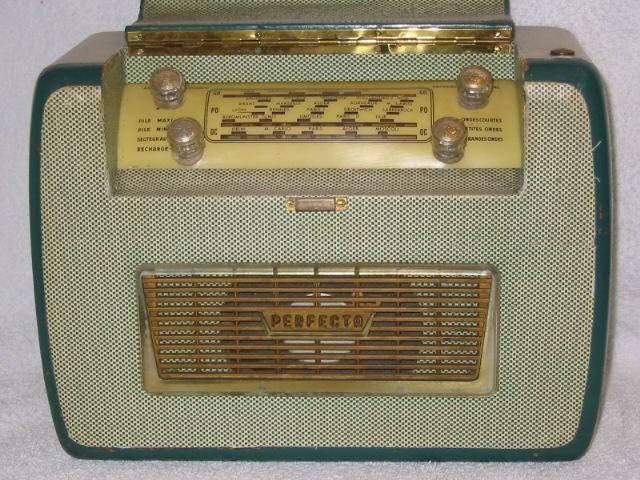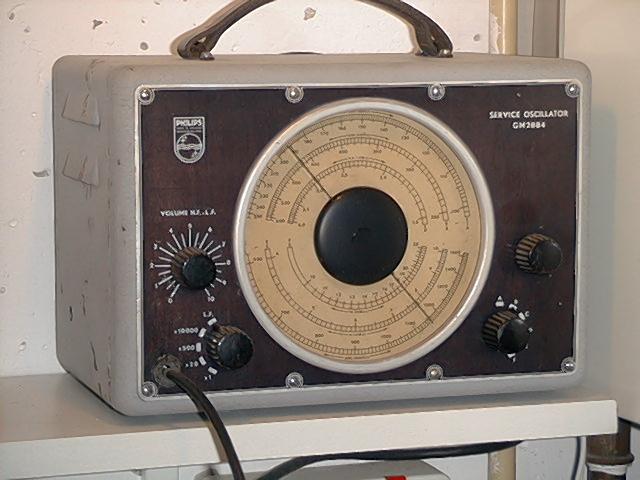
137
Item nr.

Perfecta Tube portable
High end tube portable.
Data for Perfecta
| Production | France, 1954.
|
|---|
| Bands | LW, MW, SW (22-65 m). |
|---|
| Tubes | DF96 (RF pre-amp), DK96 (converter), DF96 (IF stage), DAF96 (detector and AF stage), DL96 (output). |
|---|
Semi-
conductors | E125C150 (rectifier). |
|---|
| Cabinet | Wood.
Size 29x21x14 cm.
Weight 3.0 kg. |
|---|
| Power | Batt or AC. |
|---|
The Design
This portable is among the last generation, those employing the miniature tubes with 25mA filament current. These tubes, with type numbers D*96, were introduced around 1954. Earlier portables used similar tubes with 50mA heaters (like this Highness), or Rimlock or Locktal tubes, also with 50mA filaments.The nice things about the portable are its stage of RF amplification, three wave bands, and the possibility to supply it from AC/DC mains (with some care because it is a 110V portable although it was produced and used in France!).
| Obtained | 11/1999
from Brocante Bordeaux. |
|---|
| Condition | 8. |
|---|
| Disposed | Sold 3/2015. |
|---|
| Sound sample | PLAY SOUND On Long Wave, a few French stations are still found. The sound of the radio is clear and stable, and understandibility is good. |
|---|
This Object
In November 1999 I visited the French city of Bordeaux and found this tube portable in a local Brocante. Cleaning and repairing the cabinet was the usual job. Except from the whip antenna, of which I pulled one section completely out of the other. Fortunately, Piet Hoen had once written me about a whip operation, and I sacrificed an old TV antenna to see what was inside and to practice my whip antenna operation skills. Then I was able to repair the Perfecta whip with what remained of the TV antenna. The electrical repair wasn't peculiarly difficult, but took me some time because there were a few very uncommon problems.

 These little portables are sometimes a bit difficult to take apart, but this one is OK. Just pull out the antenna connector next to the HF tube, then unscrew two bolts on the chassis, and pull it backward. The loudspeaker remains inside the cabinet, and so does the output transformer. After a quite standard repair (replacing capacitors and rectifier) I got sound from the radio, but it was terribly distorted.
These little portables are sometimes a bit difficult to take apart, but this one is OK. Just pull out the antenna connector next to the HF tube, then unscrew two bolts on the chassis, and pull it backward. The loudspeaker remains inside the cabinet, and so does the output transformer. After a quite standard repair (replacing capacitors and rectifier) I got sound from the radio, but it was terribly distorted.
 At first I had even difficulty to find where it occurred, because the construction of the radio makes it impossible to measure while the set plays: either the antennas or the speaker must be disconnected to get under the chassis. So I had to dig out a Signal generator and my oscilloscope to diagnose the problem. It turned out that the control grid of the output tube was clean, while the plate was terribly distorted. Voltages on the tube seemed to be OK and changing the tube made no difference. My problem was, I had not given attention to the grid bias being quite high, because with other radios this never causes a distortion problem. Because the grid bias is always obtained from the cathode current running through some resistance, an output tube can never choke itself. In this set the bias is obtained independently of the cathode current, namely, from the heater chain. The bias was over 10V, which caused the tube to operate near cut-off (current 0.5 mA). I had to increase a series resistor to reduce filament current, and thus bias.
At first I had even difficulty to find where it occurred, because the construction of the radio makes it impossible to measure while the set plays: either the antennas or the speaker must be disconnected to get under the chassis. So I had to dig out a Signal generator and my oscilloscope to diagnose the problem. It turned out that the control grid of the output tube was clean, while the plate was terribly distorted. Voltages on the tube seemed to be OK and changing the tube made no difference. My problem was, I had not given attention to the grid bias being quite high, because with other radios this never causes a distortion problem. Because the grid bias is always obtained from the cathode current running through some resistance, an output tube can never choke itself. In this set the bias is obtained independently of the cathode current, namely, from the heater chain. The bias was over 10V, which caused the tube to operate near cut-off (current 0.5 mA). I had to increase a series resistor to reduce filament current, and thus bias.
 The filament current is very critical! With 13V over the entire chain the DL96 is cut off as described above. With 10V or less on the chain the heaters don't heat enough and the radio does not work at all.
The filament current is very critical! With 13V over the entire chain the DL96 is cut off as described above. With 10V or less on the chain the heaters don't heat enough and the radio does not work at all.
Then I had problems with the B+ voltage. I measured 80V on the first filter cap and 40V on the second; this indicated an extremely large current taken from the plate supply! No tube consumed excessive current, and during my measurements the voltage dropped even further. I then noticed that the filter caps were running hot, so I concluded that they were leaky. Replacing the cap solved the problem.

 The chassis was also used in a larger wood radio of brand Marquett. This model was offered in September 2010 on the Forum for Old Radios.
The chassis was also used in a larger wood radio of brand Marquett. This model was offered in September 2010 on the Forum for Old Radios.
Part of Gerard's Radio Corner.
Generated by SiteBuilder on
26/2/2024
by Gerard
(g.tel@uu.nl)

 These little portables are sometimes a bit difficult to take apart, but this one is OK. Just pull out the antenna connector next to the HF tube, then unscrew two bolts on the chassis, and pull it backward. The loudspeaker remains inside the cabinet, and so does the output transformer. After a quite standard repair (replacing capacitors and rectifier) I got sound from the radio, but it was terribly distorted.
These little portables are sometimes a bit difficult to take apart, but this one is OK. Just pull out the antenna connector next to the HF tube, then unscrew two bolts on the chassis, and pull it backward. The loudspeaker remains inside the cabinet, and so does the output transformer. After a quite standard repair (replacing capacitors and rectifier) I got sound from the radio, but it was terribly distorted.

 At first I had even difficulty to find where it occurred, because the construction of the radio makes it impossible to measure while the set plays: either the antennas or the speaker must be disconnected to get under the chassis. So I had to dig out a
At first I had even difficulty to find where it occurred, because the construction of the radio makes it impossible to measure while the set plays: either the antennas or the speaker must be disconnected to get under the chassis. So I had to dig out a  The filament current is very critical! With 13V over the entire chain the DL96 is cut off as described above. With 10V or less on the chain the heaters don't heat enough and the radio does not work at all.
The filament current is very critical! With 13V over the entire chain the DL96 is cut off as described above. With 10V or less on the chain the heaters don't heat enough and the radio does not work at all.
 The chassis was also used in a larger wood radio of brand Marquett. This model was offered in September 2010 on the Forum for Old Radios.
The chassis was also used in a larger wood radio of brand Marquett. This model was offered in September 2010 on the Forum for Old Radios.